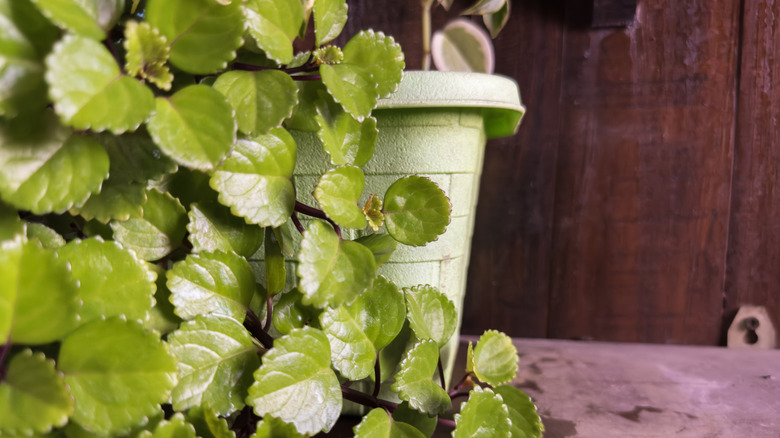The Dependable Houseplant That's Been In The White House Since 1961
Did you know there's not only a Commander-in-Chief at the White House, but also a commander-in-plant? It's a pretty hardy one that's been there for approximately 63 years and witnessed over 10 presidential terms. Commonly called the "Oval Office Swedish Ivy," this plant was allegedly presented as a gift to President John F. Kennedy by the then-ambassador of Ireland, Thomas Kiernan. We say allegedly because there hasn't been any evidence to support this, although the story is pretty infamous. But what we do know is that this ivy has graced the mantle of the Oval Office for decades, changing shape from time to time but remaining resolute, just like the desk that sits opposite it. Amazingly, it has its own Instagram handle and even boasts a Times Magazine feature!
Even more intriguing is the fact that this plant could also be living in a house close to you. Clippings from the presidential ivy have been shared among White House staff and visitors over the years. And they've in turn given cuttings to family and friends, making this probably the most distributed single plant in the United States. This living heirloom connects everyday gardeners to history in a way few plants can. Recently, keen admirers of the plant noticed that the ivy seems to have disappeared from the Oval Office mantle. But it's only been moved to the greenhouse, according to an article by the Washington Post, so it is still safe within the White House premises.
How is the Swedish Ivy able to last that long?
Let's start by pointing out that this plant is neither Swedish nor an ivy. Despite its name, the Swedish ivy (Plectranthus verticillatus) actually belongs to the mint family, Lamiaceae, and is naturally found in southern Africa, not Sweden. It's believed the plant became popular in Sweden, then globally, after Swedish sailors returned with it from South Africa. Because its trailing stems are similar in look to ivy, the name stuck.
As for why this houseplant has an abnormally long life, well, we blame its sheer hardiness. Unlike diva plants (like the hard-to-grow Boston fern) that wilt at the first sign of imperfect humidity, this one tolerates many conditions. It grows best in bright, indirect light but won't throw a fit if stuck in a dimmer corner for a while. It will still grow, just a bit slower. And you do not need to water it daily. The Swedish ivy only needs watering when the first inch of topsoil is dry to the touch, and it's preferred that you underwater instead of overwater since the plant is susceptible to root rot. Talk about a plant that thrives on negligence! As for humidity, this plant is okay with normal household humidity levels, although it prefers a more humid environment. Swedish ivy isn't picky with soil either. Yes, it would rather be in well-draining soil that doesn't dry out too quickly, but it can make do with most soil types. It's also relatively pest- and disease-free, but you should still be on the lookout for spider mites and mealy bugs.
How to grow your own Swedish Ivy
You're going to need to know this in case you get a cutting of the Oval Office Swedish Ivy someday. Now, we know caring for this houseplant can be surprisingly easy, but there really isn't a houseplant you can't kill, so you should stick to the plant's ideal conditions as much as possible. Your stem cutting should not have flowers, be four to six inches long, and be pruned just below the leaf node with the lower leaves removed to prevent rotting. The best time to prune a cutting for propagation is in the spring or summer after the flowers have bloomed. Always ensure your pruning shears are disinfected before using them.
After you have your cutting, pour good potting mix into a small pot then use a pencil or your finger to create a hole. Insert your cutting into the hole at least two leaf nodes deep and gently tamp down the soil around the cutting to keep it secure. Keep the soil damp and place it in bright, indirect light. The soil needs to be moist but not overwatered, so mist the plant occasionally. Roots typically develop within two to three weeks. To check for root growth, gently tug on the cutting — if you feel resistance, roots have formed.
Alternatively, you can place the cutting in water after pruning instead of in soil. Change out the water every two to three days, and roots will appear in about two to three weeks. Transplant the ivy into a larger pot with good drainage when the roots have fully developed in about four to six weeks.


